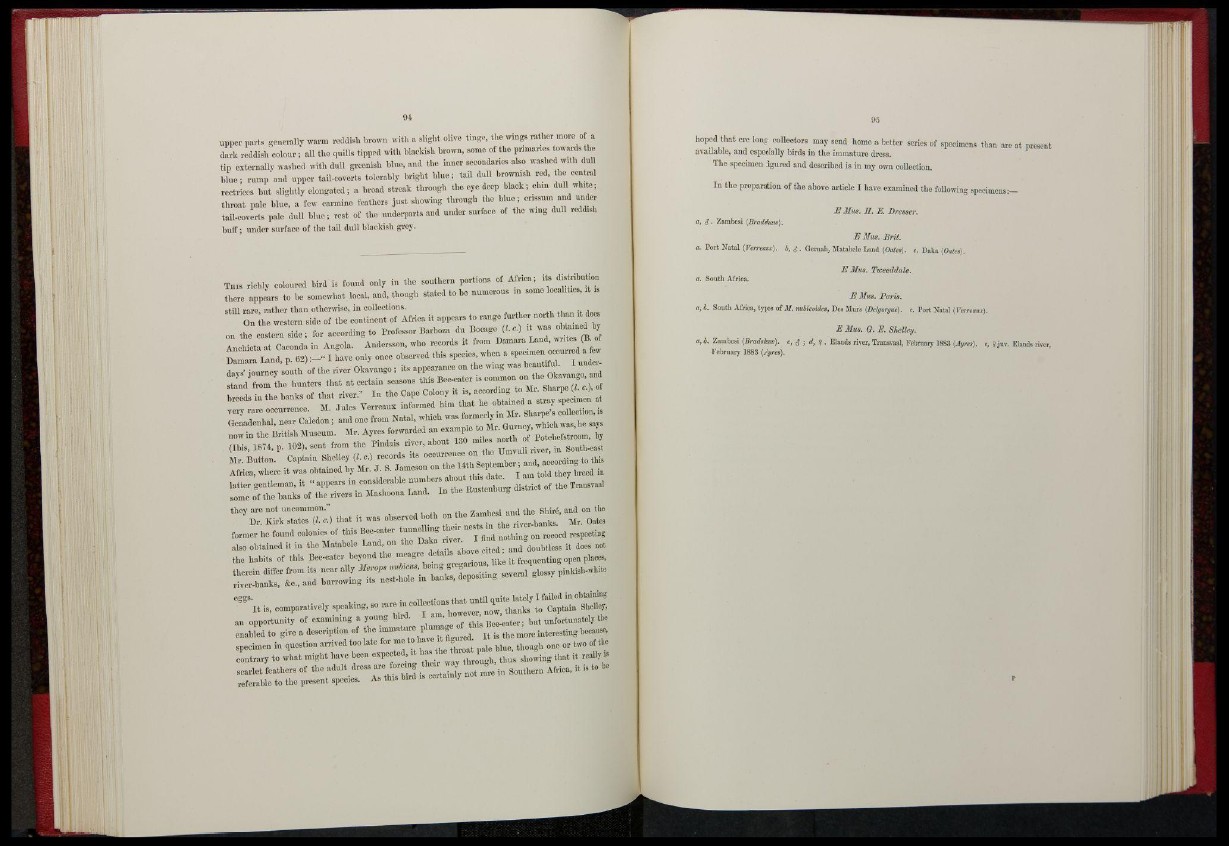
Tins richly coloured bird is found only in the southern portions of Africa; its distribution
there appears to bo somewhat local, and, though stated to he numerous in some localities, it is
still rare, rather than otherwise, in collections.
On the western side of the continent of Africa it appears to range further north than it does
on the eastern side; for according to Professor Barbozn du Bocago (/. c.) it was obtained by
Anebieta at Caeonda in Angola. Andersson, who records it from Damara Land, writes (B. of
Damara Land, p. 62):—" I have only once observed this species, when a specimen occurred a few
days' journey south of the river Okavango ; its appearance on the wing was beautiful. I understand
from the hunters that at certain seasons this Bee-eater is common on the Okavango, and
breeds in the banks of that river." In the Cape Colony it is, according to Mr. Sharpe (I. c), of
very rare occurrence. M. Jules Verreaux informed him that he obtained a stray specimen at
Genadenbal, near Caledon; and one from Xatal, which was formerly in Mr. Sharpe's collection, is
now in the British Museum. Mr. Ayres forwarded an example to Mr. Curney, which was, he says
(Ibis, 1874, p. 102), sent from the I'indais river, about 130 miles north of Potchcfstroom, by
Mr. Button. Captain Shelley (I. e.) records its occurrence on the Umvuli river, in South-east
Africa, where it was obtained by Mr. J . S. Jameson on the 11th September; and, according to this
latter gentleman, it "appears in considerable numbers about this date. I am told they breed in
some of the banks of the rivers in Mashoona Land. In the Rustcnburg district of the Transvaal
they arc not uncommon."
Dr. Kirk states (I. c.) that it was observed both on the Zambesi and the Shire', and on the
former he found colonies of this Bee-eater tunnelling their nests in the river-banks. Mr. Oates
also obtained it in the Matahele Land, on t h e Daka river. I find nothing on record respecting
the habits of this Bee-eater beyond the meagre details above cited; and doubtless it does not
therein dilfer from its near ally Merops nulneus, being gregarious, like it frequenting open places,
river-banks, &c, and burrowing its nest-hole in bants, depositing several glossy pinkish-white
I t is, comparatively speaking, so rare in collections that until quite lately I failed in obtaining
an opportunity of examining a young bird. I am, however, now, thanks to Captaiu Shelley,
enabled to give a description of the immature plumage of this Bee-eater; but unfortunately the
specimen in question arrived too late for me to have it figured. I t is the more interesting because,
contrary to what might have been expected, it has the throat pale blue, though one or two of the
scarlet feathers of the adult dress are forcing their way through, thus showing that it really is
referable to t h e present species. As this bird is certainly not rare in Southern Africa, it is to be
hoped that ere long collectors may send home a better series of specimens than are at present
available, and especially birds in the immature dress.
The specimen figured and described is in my own collection.
In the preparation of the above article I have examined the following specimens:—
E Mua. LJ. E. Dresser.
a, <J. Zambesi (Bradskaw).
E Mils. Brit.
a. Port Natal (Verreaur). b, J . Geruah. Matahele Land (Oates). e. Daka [Oates).
E Mua. Ttceeddale.
a. South Africa.
E Mua. Paris.
a, b. South Africa, types of M. nubicoides, Dcs Murs (Detgorgue). c. Port Natal (Verreaux).
E Mus. O. E. Shelley.
a, b. Zamlwsi (Bradshaw). c, 3 ; d, J . Elands river, Transvaal, February 1883 [Ayres), e, 9 juv. Elands rircr,
February 1883 (Ayres).
P
upper parts generally warm reddish brown with a slight olive tinge, the wings rather more of a
dark reddish colour ; all the quills tipped with blackish brown, some of the primaries towards the
tip externally washed with dull greenish blue, and the inner secondaries also washed with dull
blue; rump and upper tail-coverts tolerably bright blue; tail dull brownish red, t he central
reetrices but slightly elongated; a broad streak through the eye deep black; chin dull white;
throat pale blue, a few carmine feathers just showing through the blue; crissum and under
tail-coverts pale dull blue; rest of the underparts and under surface of the wing dull reddish
buff; under surface of the tail dull blackish grey.